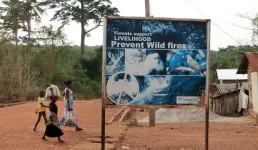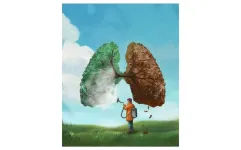(Press-News.org) American Geophysical Union
Press Release 24-19
2 May 2024
For Immediate Release
This press release is available online at: https://news.agu.org/press-release/africa-forest-fires-doubled-drying
Wildfires in wet African forests have doubled in recent decades
Climate change and human activities like deforestation are causing more fires in central and west Africa’s wet, tropical forests, according to the first-ever comprehensive survey there. The fires have long been overlooked.
AGU press contact:
Rebecca Dzombak, news@agu.org (UTC-4 hours)
Contact information for the researchers:
Michael Wimberly, University of Oklahoma, mwimberly@ou.edu (UTC-5 hours)
The author should be contacted directly for interview requests.
WASHINGTON — A new study presents the first large-scale analysis of fire patterns in west and central Africa’s wet, tropical forests. The number of active fires there typically doubled over 18 years, particularly in the Congo Basin. The increases are primarily due to increasingly hot, dry conditions and humans’ impact on the forests, including deforestation. The increase in forest fires is likely to continue given current climate projections, according to the study.
With fires increasing in other historically wet forests, such as the U.S. Pacific Northwest and the Amazon, wet forest fires can no longer be ignored, the researchers say.
Scientists have known for decades that wet forests in western and central Africa have fires, but because the fires tend to be much smaller than their counterparts in dry woodlands and savannas, relatively little research has been done on Africa’s tropical forest fires. This has led to uncertainty over where and when they burn, what exacerbates them and how that might shift in response to climate change.
“Historically, scientists have not considered fire to be an important part of wet, tropical forests, but there’s been work in the Amazon in recent decades that has suggested otherwise,” said Michael Wimberly, an ecologist at the University of Oklahoma who led the study. “We need to start thinking about wet forests as being susceptible to fires and considering fire an important impact of climate change in tropical forests.”
The study was published in Geophysical Research Letters, which publishes high-impact, short-format reports with immediate implications spanning all Earth and space sciences.
Drier forests, frequent fires
Previous research on fires in wet, tropical African forests has typically focused on relatively small areas or used datasets that were not representative of the whole forest system. Wimberly’s new study is the first comprehensive assessment fire patterns in wet African forests, which are mostly ignited by humans.
The researchers used satellite imagery to track active fires from 2003 to 2021 in western and central Africa, including the Congo Basin. The researchers found an unambiguous increase in fire frequency over time. The greatest increases were in the Northwest Congolian Lowland Forests, where there were 400 more active fires per 10,000 square kilometers (3,861 square miles) annually, in 2021 as compared to 2003. Across most of the Congo Basin, active fire densities typically doubled over the study period.
Areas with rapid forest loss, or deforestation, also saw more fire activity. Deforestation is associated with high levels of human activity and fragments the remaining forests, increasing the length of exposed edges where most fires burn. A forest’s edge has a drier microclimate and more invasive species than interior forests, making it more susceptible to fire.
The researchers also compared fire occurrences to weather patterns and found clear associations between fires, high temperatures and vapor pressure deficit, which is an indicator of plant water stress. They found a particularly strong relationship during the 2015-2016 “super El Niño,” which brought anomalous heat and drought conditions to tropical Africa.
“I was surprised at how strong and clear the climate signal was,” Wimberly said.
The findings provide critical insights into how climate change could influence African forest fire activity, particularly during El Niño years, and highlight the need to control fires at forests’ edges to prevent harmful feedback loops: A fire-affected forest is more likely to have less canopy cover and more fragmentation, increasing its fire risk.
“Tropical forest fires have been long overlooked, but they’re only going to become more important in the future,” Wimberly said. “We can’t ignore them any longer.”
#
Notes for journalists:
This study is published in Geophysical Research Letters, an open-access AGU journal. Neither this press release nor the study is under embargo. View and download a pdf of the study here.
Paper title:
“Increasing fire activity in African tropical forests is associated with deforestation and climate change”
Authors:
Michael C. Wimberly (corresponding author), Dan Wanyama, Department of Geography and Environmental Sustainability, University of Oklahoma, OK, USA, now at Department of Geography, University of Connecticut, CT, USA
R. Doughty, College of Atmospheric and Geographic Sciences, University of Oklahoma, OK, USA
H. Peiro, College of Atmospheric and Geographic Sciences, University of Oklahoma, OK, USA; and Netherlands Institute for Space Research, Leiden, the Netherlands
S. Crowell, College of Atmospheric and Geographic Sciences, University of Oklahoma, OK, USA; and LumenUs Scientific, OK, USA
AGU (www.agu.org) is a global community supporting more than half a million advocates and professionals in Earth and space sciences. Through broad and inclusive partnerships, AGU aims to advance discovery and solution science that accelerate knowledge and create solutions that are ethical, unbiased and respectful of communities and their values. Our programs include serving as a scholarly publisher, convening virtual and in-person events and providing career support. We live our values in everything we do, such as our net zero energy renovated building in Washington, D.C. and our Ethics and Equity Center, which fosters a diverse and inclusive geoscience community to ensure responsible conduct.
END
Wildfires in wet African forests have doubled in recent decades
Climate change and human activities like deforestation are causing more fires in central and west Africa’s wet, tropical forests, according to the first-ever comprehensive survey there. The fires have long been overlooked.
2024-05-02
ELSE PRESS RELEASES FROM THIS DATE:
Dietary changes may treat pulmonary hypertension
2024-05-02
Blood vessels in the lungs aren’t like the others in the body. This difference becomes clear in pulmonary hypertension, in which only the lungs’ blood vessels stiffen progressively, leading to chronic lung disease, heart failure and death. The underlying reasons for this organ-specific vessel stiffening remained a mystery until University of Pittsburgh researcher Stephen Chan and colleagues made a surprising discovery about these blood vessel cells in patients with pulmonary hypertension—they’re hungry.
Chan, Vitalant Chair in Vascular Medicine and Professor of Medicine in the Division ...
UTA scientists test for quantum nature of gravity
2024-05-02
Einstein’s theory of general relativity explains that gravity is caused by a curvature of the directions of space and time. The most familiar manifestation of this is the Earth’s gravity, which keeps us on the ground and explains why balls fall to the floor and individuals have weight when stepping on a scale.
In the field of high-energy physics, on the other hand, scientists study tiny invisible objects that obey the laws of quantum mechanics—characterized by random fluctuations that create ...
SCAI announces recipients of 2024 early career research grants
2024-05-02
Today, the Society for Cardiovascular Angiography & Interventions (SCAI) announced the recipients of the 3rd Annual SCAI Early Career Research Grants. SCAI offers this initiative to support the next generation of interventional cardiologists, providing a platform for junior-level investigators within 10 years of completing an interventional cardiology fellowship to study high-priority, clinically important topics and have their findings disseminated through various professional channels. This year’s grants are funded by support from Edwards Lifesciences, Medtronic, and Shockwave Medical.
“Research funding is often ...
AI can tell if a patient battling cancer needs mental health support
2024-05-02
Researchers at UBC and BC Cancer have developed a new artificial intelligence (AI) model that can accurately predict if a person receiving cancer care will require mental health services during their treatment journey.
The AI uses natural language processing and advanced neural networks to analyze an oncologist’s notes from their first consultation appointment with a patient. While these appointments are typically highly focused on a patient’s medical history and treatment options, the AI picks ...
ISSCR announces Hong Kong, SAR as location for its 2025 Annual Meeting
2024-05-02
The world’s leading stem cell scientists will convene in Hong Kong, SAR, 11-14 June 2025 for the International Society for Stem Cell Research (ISSCR) 2025 Annual Meeting, illuminating the future of stem cell science and highlighting the most compelling research and clinical advances of the year. The meeting is co-sponsored by The University of Hong Kong, The Chinese University of Hong Kong, and Hong Kong University of Science and Technology. The Hong Kong Innovation and Technology Commission and the Hong Kong Convention and Exhibition Centre provided significant support to enable the ISSCR to bring its hallmark event to the city of ...
Zoology: First report of wound treatment by a wild animal using a medicinal plant
2024-05-02
A wild male Sumatran orangutan (Pongo abelii) has been observed applying chewed leaves from Akar Kuning (Fibraurea tinctoria) — a climbing plant used in traditional medicine to treat wounds and conditions such as dysentery, diabetes, and malaria — to a wound on his cheek. The findings, which are published in Scientific Reports, represent the first report of suspected wound treatment by a wild animal using a plant with known medicinal properties.
Prior to this study, multiple ...
Longer interval between first colonoscopy with negative findings for colorectal cancer and repeat colonoscopy
2024-05-02
About The Study: This cohort study found that for the population without a family history of colorectal cancer (CRC), the 10-year interval between colonoscopy screenings for individuals with a first colonoscopy with findings negative for CRC could potentially be extended to 15 years. A longer interval between colonoscopy screenings could be beneficial in avoiding unnecessary invasive examinations.
Authors: Mahdi Fallah, M.D., Ph.D., of the German Cancer Research Center in Heidelberg, is the corresponding ...
Smoking cessation after initial treatment failure with varenicline or nicotine replacement
2024-05-02
About The Study: For individuals who smoked but did not achieve abstinence after treatment with varenicline, increasing the dosage enhanced abstinence versus continuing, whereas for nonabstainers initially treated with combined nicotine replacement therapy, a dosage increase or switch to varenicline enhanced abstinence and may be viable rescue strategies.
Authors: Paul M. Cinciripini, Ph.D., of the University of Texas MD Anderson Cancer Center in Houston, is the corresponding author.
To access the embargoed study: Visit our For The Media website at this link https://media.jamanetwork.com/
(doi:10.1001/jama.2024.4183)
Editor’s Note: Please see the article ...
How the brain’s arousal center helps control visual attention too
2024-05-02
The locus coeruleus (LC) is a small region of the brainstem that produces norepinephrine, a chemical with powerful effects on arousal and wakefulness which plays an important role in the body’s response to stress or panic. Now, research from the University of Chicago shows it plays a specific role in visual sensory processing as well.
In a new study published in Neuron, neuroscientists artificially increased neuronal activity in the LC by briefly shining light on genetically modified neurons. They saw that this manipulation selectively enhanced performance in non-human primates performing a visual attention task, underscoring the crucial role that attention plays in sensory ...
Increasing doses of varenicline or nicotine replacement helps persistent smokers quit
2024-05-02
HOUSTON ― For most smokers, quitting on the first attempt is likely to be unsuccessful, but a new study from The University of Texas MD Anderson Cancer Center found patients were more likely to quit if their cessation regimen was altered and doses were increased. Researchers also found that varenicline, a cessation medication, was more effective than combined nicotine replacement therapy (CNRT), such as patches or lozenges.
The study, published today in JAMA, revealed smokers who failed to quit with varenicline in the trial’s first phase were seven times more likely to quit by the end of the second phase if varenicline ...
LAST 30 PRESS RELEASES:
Scalable and healable gradient textiles for multi‑scenario radiative cooling via bicomponent blow spinning
Research shows informed traders never let a good climate crisis go to waste
Intelligent XGBoost framework enhances asphalt pavement skid resistance assessment
Dual-function biomaterials for postoperative osteosarcoma: Tumor suppression and bone regeneration
New framework reveals where transport emissions concentrate in Singapore
NTP-enhanced lattice oxygen activation in Ce-Co catalysts for low-temperature soot combustion
Synergistic interface engineering in Cu-Zn-Ce catalysts for efficient CO2 hydrogenation to methanol
COVID-19 leaves a lasting mark on the human brain
Scientists use ultrasound to soften and treat cancer tumors without damaging healthy tissue
Community swimming program for Black youth boosts skills, sense of belonging, study finds
Specific depressive symptoms in midlife linked to increased dementia risk
An ‘illuminating’ design sheds light on cholesterol
Who is more likely to get long COVID?
Study showcases resilience and rapid growth of “living rocks”
Naval Research Lab diver earns Office of Naval Research 2025 Sailor of the Year
New Mayo-led study establishes practical definition for rapidly progressive dementia
Fossil fuel industry’s “climate false solutions” reinforce its power and aggravate environmental injustice
Researchers reveal bias in a widely used measure of algorithm performance
Alcohol causes cancer. A study from IOCB Prague confirms damage to DNA and shows how cells defend against it
Hidden viruses in wastewater treatment may shape public health risks, study finds
Unlock the power of nature: how biomass can transform climate mitigation
Biochar reshapes hidden soil microbes that capture carbon dioxide in farmland
Reducing saturated fat intake shows mortality benefit, but only in high-risk individuals
Manta rays create mobile ecosystems, study finds
Study: Mixed results in using lipoic acid to treat progressive multiple sclerosis
Norbert Holtkamp appointed director of Fermi National Accelerator Laboratory
New agentic AI platform accelerates advanced optics design
Biologists discover neurons use physical signals — not electricity — to stabilize communication
Researchers discover that a hormone can access the brain by hitchhiking
University of Oklahoma researcher awarded funding to pursue AI-powered material design
[Press-News.org] Wildfires in wet African forests have doubled in recent decadesClimate change and human activities like deforestation are causing more fires in central and west Africa’s wet, tropical forests, according to the first-ever comprehensive survey there. The fires have long been overlooked.






